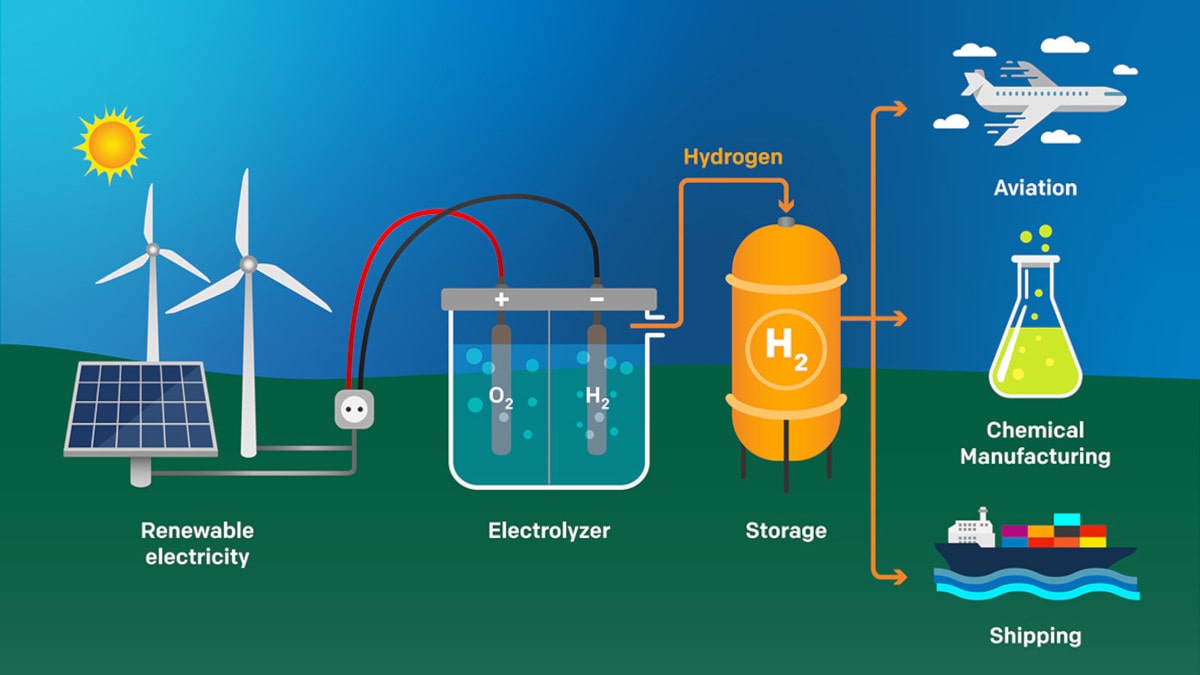Hydrogen (H2 or molecular hydrogen) has long been considered a promising alternative fuel source to reduce greenhouse gas emissions and combat climate change.
But what exactly is Green Hydrogen? Is it “Green” actually?
Why is it gaining so much attention in the energy industry?

Green Hydrogen (GH2), also known as renewable hydrogen, is produced through a process called electrolysis of water. This involves using electricity from renewable sources, such as solar or wind power, to split water molecules into hydrogen and oxygen. The resulting hydrogen gas can then be used as a clean energy source for various applications. So it is stored in tanks for future use.
The benefits of Green Hydrogen.
One of the key benefits of green hydrogen is its potential to decarbonize sectors that are difficult to electrify directly. As of now, industrial benefits are more, but later we can use it for home as well.
Industries such as steel production, heavy transportation, and chemical manufacturing heavily rely on fossil fuels and contribute significantly to CO2 emissions. By replacing fossil fuels with green hydrogen, these industries can reduce their carbon footprint.
Green hydrogen also offers a solution to energy storage and grid flexibility issues.
Renewable energy sources like solar and wind power are intermittent, meaning they only generate electricity when the sun shines or the wind blows. By converting excess renewable energy into hydrogen during periods of high generation and using it later when the renewable energy supply is low, green hydrogen can help balance the grid and ensure a continuous energy supply.
The state of Green Hydrogen development.
While the concept of green hydrogen is not new, its development and adoption have been relatively slow due to economic and technological challenges. However, in recent years, there has been a big surge of interest and investment in the green hydrogen sector due to sudden climate change.
Governments, companies, and researchers are now focusing more on developing a cost-effective electrolysis technologies and scaling up green hydrogen production.
Additionally, partnerships are being formed between renewable energy producers, electrolyzer manufacturers, and end users to create a green hydrogen value chain.
The role of Green Hydrogen in a sustainable future.
Classic fuels may not be the solution for our future energy needs, whereas Green Hydrogen has the potential to play a crucial role in achieving a sustainable and low-carbon future.
Its versatility as an energy carrier and storage medium, along with its potential to decarbonize hard-to-abate sectors, makes it an attractive option for reducing greenhouse gas emissions.
In the transportation sector, green hydrogen can power fuel cell electric vehicles (FCEVs), offering a viable alternative to traditional internal combustion engines.
FCEVs have long driving ranges and can be refueled quickly, making them comparable to conventional vehicles in terms of convenience.
Moreover, green hydrogen can be used in the heating and cooling sector, where electrification may not be feasible or cost-effective.
By providing a clean source of heat and power, green hydrogen can help reduce reliance on fossil fuels for heating homes, commercial buildings, and industrial processes.
The challenges of Green Hydrogen adoption.
While the potential of green hydrogen is promising, there are still several challenges to overcome for its widespread adoption. The economics of green hydrogen production and distribution need further improvement to compete with fossil fuels.
Currently, electrolysis is an energy-intensive process, and the cost of electricity from renewable sources can be high. So manufacturing is the main challenge today!

Infrastructure development is another significant challenge.
Building the necessary infrastructure, including hydrogen production facilities, transport and storage systems, and refueling stations, requires substantial investment and coordination among different stakeholders.
Conclusion.
In conclusion, green hydrogen offers an exciting opportunity to transition to a more sustainable and clean energy future. All we need to do is build infrastructures and scale it, that’s all.
Its ability to decarbonize industries, provide energy storage for later use, and enable the use of renewable energy in various sectors makes it a key player in the fight against climate change.
With ongoing advancements in technology and increased support from governments and industries, the era of green hydrogen is gradually unfolding before us.
Are you ready to embrace the power of green hydrogen?
Leave a Reply